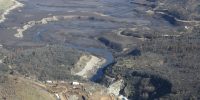A proposed dam removal caused public uproar. That’s where LightHawk came in to build stakeholder trust and gain public support.
The Nature Conservancy (TNC) New Jersey was working with other partners on a variety of projects aimed at returning the Delaware River to a clear, cold stream capable of harboring native fish and improving overall water quality. As part of that effort, they had targeted the removal of a few key dams. One such dam was on the Paulinskill, a tributary of the Delaware River in Northwestern New Jersey. The Columbia Dam was originally installed in early 1900’s to provide hydroelectric power to neighboring communities. However, over the decades the disadvantages of the dam outweighed the benefits. The dam blocked water and sediment behind it, warming the water and making it inhospitable to trout and other native cold-water species. It also blocked passage for any migratory fish swimming upriver (from the ocean up the main leg of the Delaware to reach its historic breeding habitat).

The Columbia Dam before removal. Photo by Sean Dixon-Sullivan/NextSuccession.com.
In 2014, TNC New Jersey announced they were going to work with state of New Jersey to remove the dam. There was significant public backlash. Opposition centered around the lake formed by the dam. Residents were concerned about losing the economic opportunity the lake provided with recreational anglers. They were also concerned that without the dam, the river would be accessible to invasive fish species. A public vote in November of 2016 had ⅔ voting against the dam removal.
Enter LightHawk. In June of 2016, LightHawk volunteer pilot Steve Kent flew Conservancy staff and an influential local newspaper reporter, Bruce Scrutton, up the Delaware River and the Paulinskill to provide a better understanding of the watershed and TNC New Jersey’s goals. TNC hoped to change the tone of the conflict and gain public support. This flight was really about building trust and a relationship with local media so TNC could tell their story – That they weren’t out to change things for the worse, but working to restore the river.
Bruce went on to write six stories over the next two years about TNC’s work in the Paulinskill. This was a game changer, and helped change minds about the dam removal. The dam was removed in June of 2018.

Before Scrutton’s articles were published: “This flight will hopefully result in a positive news story by this reporter about our work to restore the Paulinskill watershed during a time when some local residents are fighting one of our dam removal projects. They are saying we are outsiders making decisions for people who live there, when in fact we’ve been working in this area for more than 20 years. So this news story will hopefully orient local readers to the cool things happening in their backyards by TNC.” – Eric Olsen, TNC
“It is a special kind of satisfaction to know that American shad will no longer ‘bump their noses’ on the Columbia Dam when they return to spawn and that cleaner water will be entering the Delaware.” – Barbara Brummer, State Director of TNC New Jersey
Key Outcomes

- Dams removed in 2018.
- Shad returned to areas upriver of former dam, Spring 2019 (see article).
- Public opinion series of articles published in NJ Herald.
Lead support is provided by the William Penn Foundation


